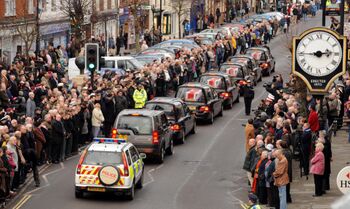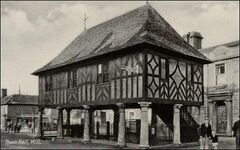Wootton Bassett

|
WARNING! This article is designed to offend. If you are not offended by it, please edit it so that you will be in the future. For an example of how to be offensive, see: Goa Tse
|
Wootton Bassett is a controversial conceptual art monument in Wiltshire, England. The monument was devised as a "living art" sculpture to commemorate Tony Blair's role in the 1st and 2nd Great Oil Wars.
History[edit]
The concept of creating a grand monument to glorify his own role in the two Great Oil Wars was devised by Tony Bliar as an attempt to prove his legacy as a heroic leader. His team of spin doctors decided that the best way to publicise the scheme would be a grand competition to design the monument. Entrants included pioneering luminaries of the art world such as Antony Gormley, Tracey Emin and Damien Hirst but the lucrative commission was won by a rank outsider called Tim Wooton with his bizarre "living art" concept.
Design[edit]
Wooton's winning design would involve the construction of an entire town, to be populated with 11,000 full-time professional patriots. The town would be situated near a military instillation and would utilise jingoism and the "grief tourism" phenomena first witnessed in the UK during the Dianamania pandemic as it's economic foundation.
Finance[edit]
The massive scale of Wootton's design necessitated huge outlay. The Blair legacy monument was going to cost billions. Tony Blair and Lord Levy called in favours from some of the recently appointed Lords and eventually Lord Harry Bassett stepped forward with a multi billion pound donation.
Naming[edit]
From the moment of inception Tony Blair's preferred name for the project was The Noble Anthony Charles Lynton Blair monument, but one of Harry Bassett's specifications in return for the funding was that the title of the monument include his name. The official name of the monument was announced on 5 May 2005 as The Wootton-Bassett Conceptual Monument, which was soon shortened to Wootton Bassett by the press and public alike.
Construction[edit]
It was decided that the monument should be built as near to RAF Lyneham as possible to maximise the "grief tourism" potential, as Lyneham is the airbase where the corpses of Blair's mercenaries are flown back to the UK.
The only suitable location for the monument was occupied by the historic county town of Wilt, which had given it's name to the county of Wiltshire. The demolition of Wilt took several months during the summer of 2006, amidst furious protests from the displaced people of Wilt, local historians and archaeologists.
Once Wilt was out of the way the Wootton Bassett memorial could be built. Many of the displaced residents of Wilt commute back to the area to work amongst the 11,000 professional patriots required to populate the monument.
Controversy[edit]
In 2010 a liberal Muslim group called Islam4UK announced that they planned to have a protest march against the glorification of war embodied in the Wootton Bassett memorial. The plans were attacked by the totalitarian Labour government and the right wing press. The Islam4UK freedom fighters were banned under the Terrorism act 2000 causing outrage amongst liberal groups. The protest did not go ahead as planned and the monument remains in operation.
Financial problems[edit]
Following the Economic recession of 2008 and the proposed severe cutbacks announced by all major political parties, there has been increasing public pressure to cut back spending on the Wootton Bassett memorial. Both Labour and the Tories have announced that they intend to ring-fence the £10 Billion annual running cost of the monument by reducing spending on military equipment for the service personnel in Iraq and Afghanistan, which should also have the added benefit of creating more income for the project through the increased frequency of the lucrative "grief parades".



